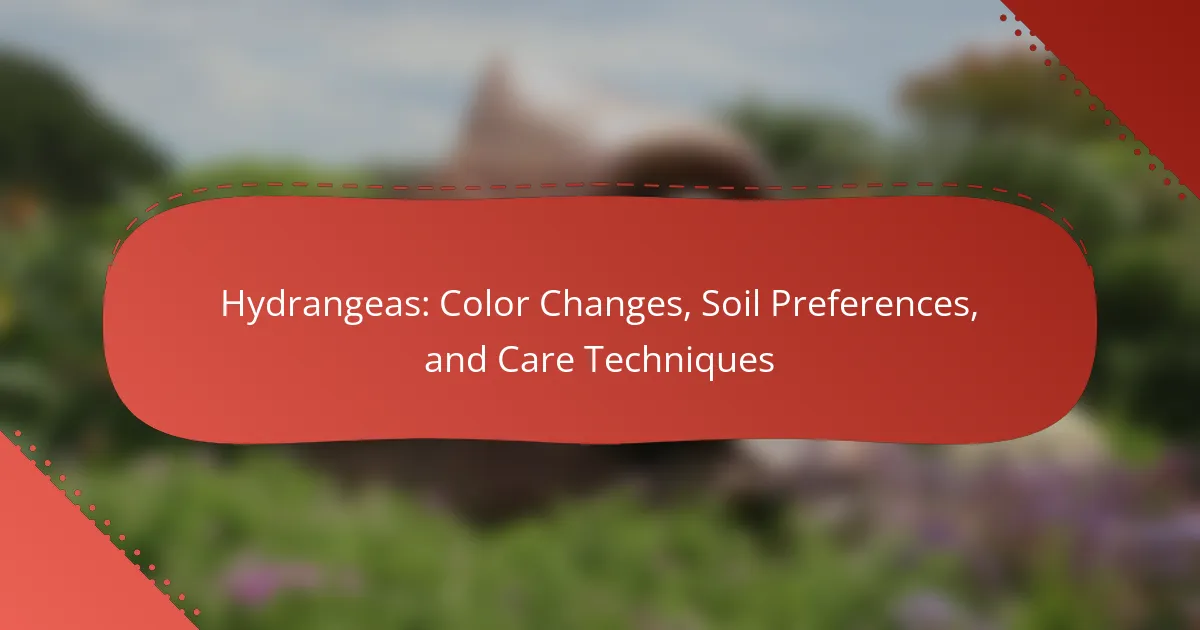
What are Hydrangeas and Why are They Popular?
Hydrangeas are flowering plants belonging to the Hydrangeaceae family. They are known for their large, colorful blooms. These plants thrive in various climates and soil types, making them versatile for gardeners. Hydrangeas are popular due to their aesthetic appeal and ability to change color based on soil pH. For example, blue blooms often occur in acidic soils, while pink blooms appear in alkaline conditions. Their long blooming period, typically from spring to fall, adds to their popularity in landscaping. Additionally, hydrangeas are relatively low-maintenance, attracting both novice and experienced gardeners.
What are the different types of Hydrangeas?
The different types of Hydrangeas include Hydrangea macrophylla, Hydrangea paniculata, Hydrangea quercifolia, Hydrangea arborescens, and Hydrangea serrata. Hydrangea macrophylla, commonly known as bigleaf hydrangea, features large, round flower clusters. Hydrangea paniculata, or panicle hydrangea, has cone-shaped flower clusters and blooms in late summer. Hydrangea quercifolia, known as oakleaf hydrangea, has oak-shaped leaves and produces white to pink flowers. Hydrangea arborescens, or smooth hydrangea, is characterized by its large, round flower heads. Hydrangea serrata, also called mountain hydrangea, is smaller and often has lacecap flower forms. These types exhibit various growth habits and flower structures, making them popular in gardens.
How do the characteristics of each type differ?
The characteristics of each type of hydrangea differ primarily in flower color, size, and growth habit. For example, Hydrangea macrophylla typically produces large, round flower clusters and can change color based on soil pH. In contrast, Hydrangea paniculata features cone-shaped flower clusters and remains white or cream regardless of soil conditions. Additionally, Hydrangea arborescens is known for its strong stems and ability to thrive in various soil types, producing large white blooms. Each type also varies in hardiness, with some being more tolerant to cold than others. These differences are crucial for gardeners to consider when selecting hydrangeas for their landscapes.
What unique features do specific Hydrangea varieties possess?
Certain Hydrangea varieties possess unique features that distinguish them. For example, Hydrangea macrophylla, known as bigleaf hydrangea, can change flower color based on soil pH. Acidic soils produce blue flowers, while alkaline soils yield pink flowers. Another variety, Hydrangea paniculata, features cone-shaped flower clusters that bloom in white and turn pink as they mature. Hydrangea arborescens, commonly called smooth hydrangea, is notable for its large, round flower heads and ability to thrive in various soil types. Additionally, the variety ‘Endless Summer’ is unique for its ability to bloom on both old and new wood, extending its flowering season. These distinctive traits contribute to the diversity and appeal of hydrangeas in gardens.
How do Hydrangeas change color?
Hydrangeas change color primarily due to the pH level of the soil they are planted in. In acidic soil (pH below 6), hydrangeas typically produce blue flowers. In alkaline soil (pH above 7), the flowers tend to be pink. Neutral pH levels usually result in purple blooms. The presence of aluminum ions in acidic soil is crucial for blue coloration. When the soil is alkaline, aluminum is less available, leading to pink flowers. This phenomenon is particularly observed in the species Hydrangea macrophylla. Soil amendments can be used to alter pH and influence flower color. Testing soil pH can help gardeners achieve desired hydrangea colors.
What factors influence the color changes in Hydrangeas?
Hydrangeas change color primarily due to soil pH levels. Acidic soil (pH below 6) typically produces blue flowers. Alkaline soil (pH above 7) usually results in pink flowers. The presence of aluminum ions in the soil also affects color. In acidic conditions, aluminum is more available, promoting blue hues. In neutral to alkaline conditions, aluminum is less available, leading to pink flowers. Additionally, specific hydrangea varieties have inherent color characteristics. These genetic traits can influence the final color, regardless of soil conditions. Environmental factors like temperature and light exposure can also play a role in color intensity.
How does soil pH affect the color of Hydrangeas?
Soil pH directly influences the color of hydrangeas. Acidic soils, with a pH below 6, typically produce blue flowers. Alkaline soils, with a pH above 7, lead to pink flowers. The presence of aluminum ions in acidic soil is responsible for the blue coloration. In neutral or alkaline conditions, aluminum availability decreases, resulting in pink hues. Research indicates that soil pH can be adjusted to manipulate flower color. For example, adding sulfur can lower pH, enhancing blue shades. Conversely, adding lime can raise pH, promoting pink flowers.

What are the Soil Preferences for Hydrangeas?
Hydrangeas prefer well-drained, fertile soil with a pH range of 5.2 to 6.2. This acidic to slightly acidic soil supports optimal growth and flowering. They thrive in loamy or sandy soils that retain moisture without becoming waterlogged. Good drainage is essential to prevent root rot. Organic matter, such as compost, enhances soil quality and nutrient availability. Hydrangeas also benefit from mulching, which helps maintain soil moisture and temperature. Research indicates that soil pH affects flower color in certain hydrangea varieties, making soil preference critical for desired outcomes.
What type of soil is best for growing Hydrangeas?
Hydrangeas thrive best in well-draining, loamy soil. This type of soil retains moisture while allowing excess water to escape. A pH level between 5.5 and 6.5 is ideal for optimal growth. Acidic soil can enhance the blue color of certain hydrangea varieties. Conversely, alkaline soil can promote pink hues. Additionally, incorporating organic matter can improve soil structure and fertility. Research indicates that hydrangeas prefer nutrient-rich environments for vibrant blooms. Proper soil conditions are essential for healthy hydrangea plants.
How does drainage impact Hydrangea health?
Drainage significantly impacts Hydrangea health. Proper drainage prevents root rot, which is a common issue for Hydrangeas. Excess water in the soil can suffocate roots and lead to fungal diseases. Hydrangeas thrive in well-drained soil that retains some moisture without becoming waterlogged. A study by the University of Georgia found that Hydrangeas in well-drained conditions exhibited stronger growth and more vibrant blooms. In contrast, poor drainage can cause stunted growth and reduced flowering. Thus, ensuring adequate drainage is crucial for maintaining healthy Hydrangeas.
What soil amendments can enhance Hydrangea growth?
Organic matter such as compost can enhance Hydrangea growth. Compost improves soil structure and nutrient availability. It retains moisture, which is crucial for Hydrangeas. Additionally, well-rotted manure provides essential nutrients. Peat moss can also acidify the soil, benefiting specific Hydrangea varieties. Soil amendments like sulfur can lower pH levels for blue blooms. Incorporating these amendments leads to healthier plants and vibrant flowers. Research shows that nutrient-rich soils support robust Hydrangea growth and flowering.
Why is soil pH important for Hydrangeas?
Soil pH is important for hydrangeas because it directly affects their ability to absorb nutrients. Hydrangeas thrive in slightly acidic to neutral soil, with a pH range of 5.5 to 7.0. Soil pH influences the availability of essential nutrients like iron and aluminum. In acidic soils, hydrangeas can produce blue flowers due to increased aluminum uptake. Conversely, alkaline soils can lead to pink flowers by limiting aluminum absorption. Research shows that soil pH can change flower color, impacting aesthetic appeal. Proper pH levels also promote healthy root development and overall plant vigor. Maintaining the right soil pH is crucial for optimal hydrangea growth and flowering.
How can you test soil pH for Hydrangeas?
To test soil pH for hydrangeas, use a soil pH test kit or meter. These tools measure the acidity or alkalinity of the soil. Collect a soil sample from the root zone of the hydrangea. Mix the sample with distilled water according to the kit instructions. Insert the pH meter or test strip into the mixture. Wait for the reading to stabilize. A pH level between 5.5 and 6.5 is ideal for hydrangeas. This range supports optimal nutrient uptake and color variation. Testing soil pH helps ensure healthy hydrangea growth.
What adjustments can be made to achieve the desired soil pH?
To achieve the desired soil pH, one can add lime or sulfur. Lime raises the soil pH, making it more alkaline. It is effective for acidic soils. Sulfur lowers the soil pH, making it more acidic. It is beneficial for alkaline soils. The amount needed depends on the soil’s current pH and texture. Testing soil pH is crucial before making adjustments. The ideal pH for hydrangeas varies by type, generally between 5.5 to 6.5. Adjustments should be made gradually to avoid shock to the plants.

What are the Care Techniques for Hydrangeas?
Hydrangeas require specific care techniques to thrive. First, ensure they receive adequate water. Hydrangeas prefer consistently moist soil, especially during dry spells. Second, provide appropriate sunlight. Most hydrangeas thrive in partial shade to full sun. Third, apply mulch to retain moisture and regulate soil temperature. Use organic mulch like bark or leaves. Fourth, prune hydrangeas at the right time. Pruning should occur after flowering for some varieties, while others benefit from early spring pruning. Fifth, fertilize with a balanced fertilizer in spring. This promotes healthy growth and vibrant blooms. Finally, monitor for pests and diseases. Regular checks can prevent infestations and maintain plant health.
How often should you water Hydrangeas?
Hydrangeas should be watered about once a week. This frequency ensures that the soil remains consistently moist. During hot and dry weather, they may require more frequent watering. It’s important to check the soil moisture before watering. If the top inch of soil feels dry, it’s time to water. Overwatering can lead to root rot, so avoid soggy soil. Hydrangeas thrive best when their roots are kept evenly moist. Proper watering promotes healthy blooms and vibrant colors.
What signs indicate that Hydrangeas need more water?
Hydrangeas need more water when their leaves start to wilt or droop. This indicates that the plant is experiencing stress due to insufficient moisture. Another sign is when the leaf edges turn brown and crispy. This browning often occurs due to dehydration. Additionally, if the blooms appear smaller than usual, it may signal a lack of water. Hydrangeas also require more water if the soil feels dry to the touch, particularly several inches down. Regularly checking these signs can help maintain healthy hydrangeas.
How can you avoid overwatering Hydrangeas?
To avoid overwatering Hydrangeas, ensure the soil has good drainage. Hydrangeas prefer consistently moist soil but can suffer from root rot if waterlogged. Check the top inch of soil; if it feels dry, it’s time to water. Use well-draining soil and consider adding organic matter to improve drainage. Water in the early morning to reduce evaporation and allow the plant to absorb moisture. Monitor rainfall and adjust your watering schedule accordingly. Overwatering can lead to yellowing leaves and wilting, indicating stress.
What fertilization practices are best for Hydrangeas?
Hydrangeas benefit from balanced fertilizers with equal parts nitrogen, phosphorus, and potassium. A 10-10-10 or 20-20-20 fertilizer works well. Apply fertilizer in early spring as new growth begins. This timing promotes healthy foliage and blooms. Additionally, a second application can be made in mid-summer. Hydrangeas also respond well to organic options, such as compost or well-rotted manure. These organic fertilizers improve soil structure and provide essential nutrients. Regular soil testing can guide specific nutrient needs for optimal growth.
What types of fertilizers are recommended for Hydrangeas?
Hydrangeas benefit from balanced fertilizers, specifically those with equal parts nitrogen, phosphorus, and potassium. A 10-10-10 or 20-20-20 NPK fertilizer is often recommended. These fertilizers support healthy growth and vibrant blooms. Additionally, slow-release fertilizers can provide nutrients over time. Organic options like compost or well-rotted manure are also beneficial. They improve soil structure and provide essential nutrients. Regular feeding during the growing season enhances flower production. Hydrangeas typically require fertilization every 4 to 6 weeks from spring to early summer.
When is the best time to fertilize Hydrangeas?
The best time to fertilize hydrangeas is in early spring. This timing allows the plants to utilize nutrients as they begin their growth cycle. Fertilizing at this time supports healthy foliage and flower development. Additionally, a second application can be made in mid-summer for continued nourishment. Using a balanced fertilizer promotes vibrant blooms. Research indicates that proper fertilization enhances overall plant health and flowering potential.
What are common pests and diseases affecting Hydrangeas?
Common pests affecting Hydrangeas include aphids, spider mites, and scale insects. Aphids are small, soft-bodied insects that suck sap from the plant. Spider mites are tiny arachnids that cause stippling on leaves. Scale insects appear as small, immobile bumps on stems and leaves.
Common diseases affecting Hydrangeas include powdery mildew, root rot, and leaf spot. Powdery mildew is a fungal infection that creates a white, powdery coating on leaves. Root rot is caused by overwatering and leads to wilting and yellowing leaves. Leaf spot is characterized by dark, water-soaked spots on leaves.
These pests and diseases can significantly impact the health and appearance of Hydrangeas. Regular monitoring and appropriate care can help manage these issues effectively.
How can you identify pests on Hydrangeas?
To identify pests on Hydrangeas, look for visible signs of damage on the leaves and stems. Common indicators include holes, discoloration, or wilting. Check for sticky residue, which may suggest aphids or scale insects. Examine the undersides of leaves for webbing, indicating spider mites. Look for small, discolored spots that could be caused by fungal infections or pests. Regular inspections can help catch infestations early. Identifying pests promptly allows for effective treatment and prevents further damage to the plant.
What treatments are effective for common Hydrangea diseases?
Effective treatments for common Hydrangea diseases include proper sanitation, fungicides, and insecticides. Sanitation involves removing infected leaves and debris to prevent disease spread. Applying fungicides can treat fungal infections like powdery mildew and leaf spot. Insecticides are useful for controlling pests that may cause damage. Regular monitoring for signs of disease ensures timely intervention. Furthermore, maintaining adequate air circulation around plants reduces humidity, which helps prevent fungal growth. Proper watering techniques can also minimize root rot and other moisture-related issues.
What are some best practices for Hydrangea maintenance?
Hydrangea maintenance involves regular watering, pruning, and fertilization. Water hydrangeas deeply, ensuring soil remains moist but not soggy. Prune them in late winter or early spring to promote healthy growth. Use a balanced fertilizer during the growing season for optimal blooming. Mulching helps retain moisture and suppress weeds. Monitor for pests and diseases, addressing issues promptly. These practices enhance the plant’s health and flowering potential.
How can you effectively prune Hydrangeas for optimal growth?
To effectively prune hydrangeas for optimal growth, identify the type of hydrangea you have. Pruning methods vary between types. For example, bigleaf hydrangeas bloom on old wood. Prune them immediately after flowering. Remove dead or weak stems to encourage new growth. For panicle and smooth hydrangeas, prune in late winter or early spring. Cut back stems to about one-third of their height. This promotes larger blooms. Always use clean, sharp pruning shears. Proper pruning enhances air circulation and reduces disease risk. Regular pruning maintains shape and encourages healthy growth.
What seasonal care tips should you follow for Hydrangeas?
Hydrangeas require specific seasonal care to thrive. In spring, prune dead or weak stems to promote healthy growth. Fertilize with a balanced fertilizer to encourage blooming. During summer, ensure consistent watering, aiming for deep hydration to avoid wilting. In fall, reduce watering as plants prepare for dormancy. Mulch around the base to insulate roots during winter. In winter, protect hydrangeas from harsh weather by covering with burlap or mulch. Proper seasonal care leads to vibrant blooms and healthy plants.
Hydrangeas are flowering plants from the Hydrangeaceae family, renowned for their large, colorful blooms and adaptability to various climates and soil types. This article covers the different types of hydrangeas, their unique characteristics, and how soil pH influences their color changes. It also details optimal soil preferences, care techniques, and common pests and diseases affecting hydrangeas. Key practices for maintaining healthy hydrangeas, including watering, fertilization, and pruning methods, are discussed to aid gardeners in achieving vibrant blooms and robust plant health.
